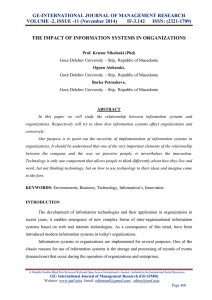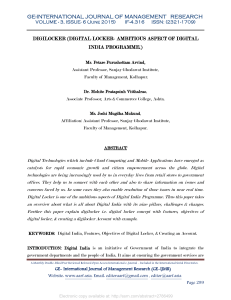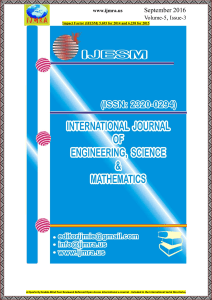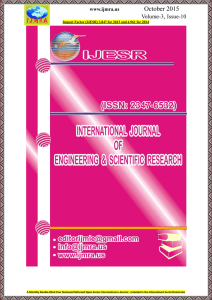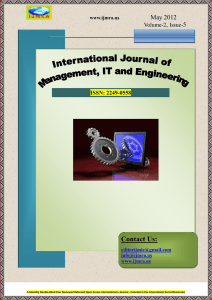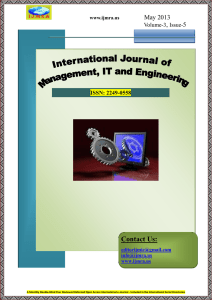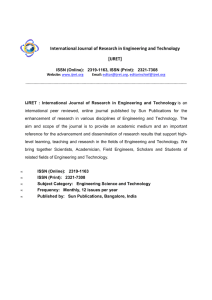GE-INTERNATIONAL JOURNAL OF MANAGEMENT RESEARCH
advertisement
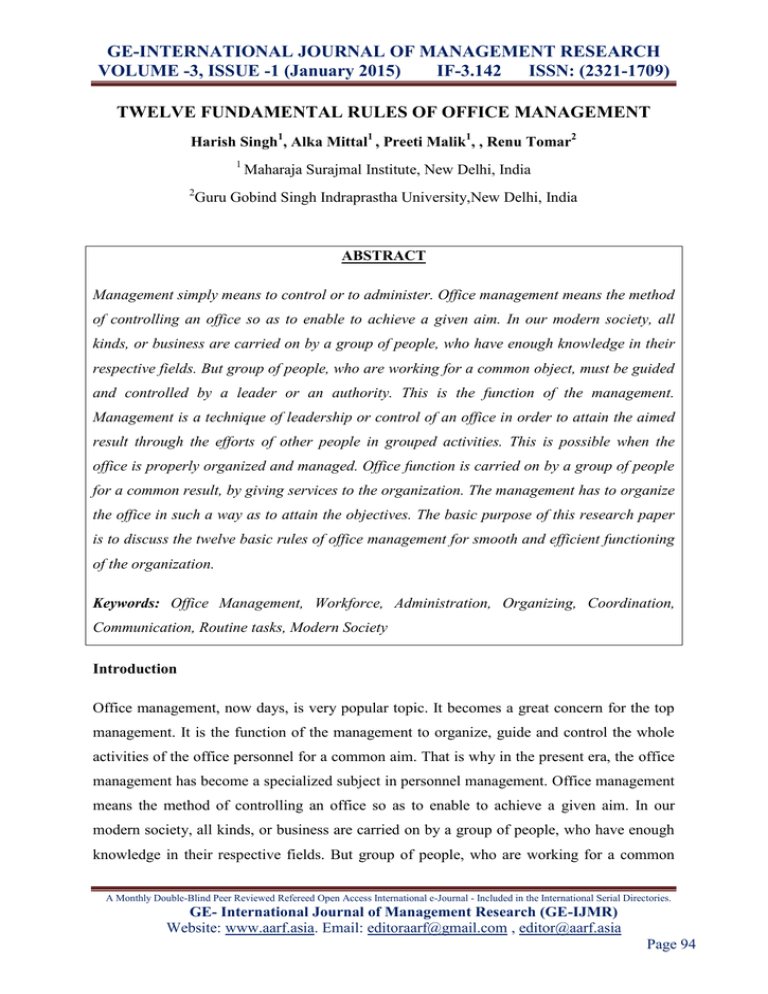
GE-INTERNATIONAL JOURNAL OF MANAGEMENT RESEARCH VOLUME -3, ISSUE -1 (January 2015) IF-3.142 ISSN: (2321-1709) TWELVE FUNDAMENTAL RULES OF OFFICE MANAGEMENT Harish Singh1, Alka Mittal1 , Preeti Malik1, , Renu Tomar2 1 2 Maharaja Surajmal Institute, New Delhi, India Guru Gobind Singh Indraprastha University,New Delhi, India ABSTRACT Management simply means to control or to administer. Office management means the method of controlling an office so as to enable to achieve a given aim. In our modern society, all kinds, or business are carried on by a group of people, who have enough knowledge in their respective fields. But group of people, who are working for a common object, must be guided and controlled by a leader or an authority. This is the function of the management. Management is a technique of leadership or control of an office in order to attain the aimed result through the efforts of other people in grouped activities. This is possible when the office is properly organized and managed. Office function is carried on by a group of people for a common result, by giving services to the organization. The management has to organize the office in such a way as to attain the objectives. The basic purpose of this research paper is to discuss the twelve basic rules of office management for smooth and efficient functioning of the organization. Keywords: Office Management, Workforce, Administration, Organizing, Coordination, Communication, Routine tasks, Modern Society Introduction Office management, now days, is very popular topic. It becomes a great concern for the top management. It is the function of the management to organize, guide and control the whole activities of the office personnel for a common aim. That is why in the present era, the office management has become a specialized subject in personnel management. Office management means the method of controlling an office so as to enable to achieve a given aim. In our modern society, all kinds, or business are carried on by a group of people, who have enough knowledge in their respective fields. But group of people, who are working for a common A Monthly Double-Blind Peer Reviewed Refereed Open Access International e-Journal - Included in the International Serial Directories. GE- International Journal of Management Research (GE-IJMR) Website: www.aarf.asia. Email: editoraarf@gmail.com , editor@aarf.asia Page 94 GE-INTERNATIONAL JOURNAL OF MANAGEMENT RESEARCH VOLUME -3, ISSUE -1 (January 2015) IF-3.142 ISSN: (2321-1709) object, must be guided and controlled by a leader or an authority. This is the function of the management. Management is a technique of leadership or control of an office in order to attain the aimed result through the efforts of other people in grouped activities. This is possible when the office is properly organized and managed. Office function is carried on by a group of people for a common result, by giving services to the organization. The management has to organize the office in such a way as to attain the objectives. Before talking further about this, it would be essential to understand the meaning of administration, management and organization. Sheldon summaries them in the following words: "Administration is the function in industry concerned in the determination of the corporate policy, the co-ordination of finance, production and distribution, the settlement of the compass of the organization and the ultimate control of the executive." "Management proper is the function in industry concerned in the execution of policy, within the limits set up by the administration and the employment of the organization for the particular objects set before it." "Organization is the process of so combining the work which individuals or groups have to perform with the faculties necessary for its execution that the duties, so framed, provide the best channels for the efficient, systematic, and positive and co-ordinate application of the available effort. Hence, it is the formation of an effective 'machine; management of an effective executive; administration of an effective direction. Administration determines the organization; management uses it. Administration defines the goal; management strives towards it. Organization is the machine of management in its achievement of the ends determined by administration." Thus "Determination of policy and co-ordination (Administration), the execution of policy and employment of organization (Management) and the combination of the work of individuals or groups with the faculties necessary for its execution (Organisation), and this altogether comprises of office management". Office management is the process of dividing work into convenient tasks or duties, of grouping such duties in the form of posts, of delegating authority to each post and of appointing qualified staff to be responsible that the A Monthly Double-Blind Peer Reviewed Refereed Open Access International e-Journal - Included in the International Serial Directories. GE- International Journal of Management Research (GE-IJMR) Website: www.aarf.asia. Email: editoraarf@gmail.com , editor@aarf.asia Page 95 GE-INTERNATIONAL JOURNAL OF MANAGEMENT RESEARCH VOLUME -3, ISSUE -1 (January 2015) IF-3.142 ISSN: (2321-1709) work is carried out as planned." Office administration denotes the function of giving birth to major policies upon which the enterprise is to be functioned. In a joint-stock company, the Board of Directors makes the major policies and in a partnership firm, the partners lay down the policies. In all kinds of business the function of administration is the same. Making the policies is the function of the administration. Research Objectives To discuss the basic rules of office management in the organization. To understand the significance of office management in present scenario. To discuss the factors which help in creating the work culture which supports the effective office management. Research Methodology The study is explorative cum descriptive in nature. It is an empirical research based upon secondary data. The theory is basically developed from secondary sources of information and a thorough study of various academic works in the relevant field has been attempted. Lifeline of the Successful Organizations (Twelve Basic Rules of the Office Management) Rule No. 1 Keep Records and make them updated Keeping records sounds like the easiest part of good office management-until you consider the need to keep those records both accessible and updated. Make this the first rule for managing office. Make updating records an office routine. When you get a new customer or client, for instance, it only takes a moment to enter him into your contact database. Then it will only take A Monthly Double-Blind Peer Reviewed Refereed Open Access International e-Journal - Included in the International Serial Directories. GE- International Journal of Management Research (GE-IJMR) Website: www.aarf.asia. Email: editoraarf@gmail.com , editor@aarf.asia Page 96 GE-INTERNATIONAL JOURNAL OF MANAGEMENT RESEARCH VOLUME -3, ISSUE -1 (January 2015) IF-3.142 ISSN: (2321-1709) Another moment or two to update the record after you’ve spoken to him on the phone. Keeping good and updated records are important. Just try keeping records in the written form or they have to be in a state which is easily accessible. Records of both your income and expenses must be updated to manage your business smoothly. Rule No. 2 Establish Office Management Routines and Stick to them Routine tasks need routine procedures if you want to stay organized and keep things running smoothly. Set up routines for handling paperwork and office systems. For instance every piece of paper that comes into your office should be handled once, acted upon and filed- not haphazardly piled on a desk. Office systems such as computer will need both administration panic mode procedures. When any system crashes or a computer related piece of equipment fails, everyone in your office needs to know who to call and what not to do. Rule No. 3 Set up clearly delineated responsibilities Good office management depends on people knowing who is responsible for what- it’s people who are accountable to get things done. What would happen, for example, if the purchasing for your business was done by whoever whenever? A Monthly Double-Blind Peer Reviewed Refereed Open Access International e-Journal - Included in the International Serial Directories. GE- International Journal of Management Research (GE-IJMR) Website: www.aarf.asia. Email: editoraarf@gmail.com , editor@aarf.asia Page 97 GE-INTERNATIONAL JOURNAL OF MANAGEMENT RESEARCH VOLUME -3, ISSUE -1 (January 2015) IF-3.142 ISSN: (2321-1709) Would you be able to find a paper clip when you wanted one? Or print off a report when you needed to? Putting one person in charge of ordering all equipments and supplies solves the problem and keeps things running smoothly. It’s the same with (computer) systems administration. You need to have one person responsible for the security of your computer system and keeping track of things such as accounts, passwords and software. Otherwise, chaos will proliferate. Rule No. 4 Take a walk through your office and have a sit Is your office an example of space management or space mismanagement? When you walk through the office, do you have to detour around obstacles or run the risk of tripping over something? When you sit down at a desk, could you actually work comfortably there? Are things logically arranged so that the things that you would use most at the desk are closest to hand? There are a lot of things crammed into offices nowadays, from printer stands through filing cabinets. For good office management, you need to be sure that all the things in the office are arranged for maximum efficiency- and maximum safety. The Basics of Small or Home Office Design provides tips for safely meeting the power, lighting and ventilation needs of your office space. Rule No. 5 Inter- and intra-office communication A Monthly Double-Blind Peer Reviewed Refereed Open Access International e-Journal - Included in the International Serial Directories. GE- International Journal of Management Research (GE-IJMR) Website: www.aarf.asia. Email: editoraarf@gmail.com , editor@aarf.asia Page 98 GE-INTERNATIONAL JOURNAL OF MANAGEMENT RESEARCH VOLUME -3, ISSUE -1 (January 2015) IF-3.142 ISSN: (2321-1709) For many small businesses, the responsibility for communication falls upon the office manager. Knowing how and when to communicate, key information is vital to successful office management. E-mail blasts, posted instructions at the copier, and weekly staff meetings are just a few of the types of communication that occur within a business office. Having a communication plan that everyone can adhere to will increase an office’s productivity and ensure that information is disseminated clearly and quickly. Inter office communication means communication between the head and staff and within the staff members too. It must be taken into consideration that the correct and full information is being circulated among the members regarding any office issues and more emphasis should be given to new staff members. Rule no. 6 Make business planning a priority Many small businesses owners spend their days acting and reacting- and then wonder why they seem to be spinning their wheels. Business planning is an important component of good office management and needs to be part of your regular office management routine. Successful small business owners must spend time every week on business planning, and many use daily business planning sessions as a tool for goal setting and growth. If you have staff, involve them in business planning, either formally or informally. A Monthly Double-Blind Peer Reviewed Refereed Open Access International e-Journal - Included in the International Serial Directories. GE- International Journal of Management Research (GE-IJMR) Website: www.aarf.asia. Email: editoraarf@gmail.com , editor@aarf.asia Page 99 GE-INTERNATIONAL JOURNAL OF MANAGEMENT RESEARCH VOLUME -3, ISSUE -1 (January 2015) IF-3.142 ISSN: (2321-1709) Don’t let chaos interfere with doing business. Business Planning involving your staff persons also reveals the intelligence status of your employees which is very crucial to keep in mind. Rule No. 7 Keep your business data in a secure location on-site So not keep your business’s computer server with all important hard drives in a spot where someone could easily grab it and run off. Good business data security starts with good physical security. All employees do not need all access to all business data and the public should not have access at all. Sensitive paper documents can be stored in locking filing cabinets and if possible, in rooms that lock separately. Give out keys only to those trusted individuals who need access. Back up your business data regularly. The steps to Successful Data Backup explain how to set up a backup system for your small business. Get your essential business documents together. Protect your business data against power outages. The key to data protection is trying to make sure that particular crises don’t happen rather than trying to recover from disaster afterwards. But investing a little time and money into data protection now will give you piece of mind and a much easier, faster business recovery if the worst happens. Rule No. 8 E-mails management A Monthly Double-Blind Peer Reviewed Refereed Open Access International e-Journal - Included in the International Serial Directories. GE- International Journal of Management Research (GE-IJMR) Website: www.aarf.asia. Email: editoraarf@gmail.com , editor@aarf.asia Page 100 GE-INTERNATIONAL JOURNAL OF MANAGEMENT RESEARCH VOLUME -3, ISSUE -1 (January 2015) IF-3.142 ISSN: (2321-1709) E-mail management starts with setting up and using filters. Do not check your email on demand. You don’t need to see every piece of email the second it arrives. If you are using an email programme that announces the arrival of new email, turn off the programme’s announcement features, such as making a sound or having a pop-up screen announce the arrival of email. Checking email on demand can seriously interfere with whatever other tasks you are trying to accomplish because most people will read email when they check it. Do not read and answer your email all day long. You may get anywhere from a handful to hundreds of emails each day that need to be answered, but they do not need to be answered immediately, interrupting whatever else you are doing. Instead, set aside a particular time each day to review and answer your email. Do not answer email at your most productive time of day. Answering email, on the other hand, is not usually a task that calls for a great deal of creativity. Rule No. 9 Conflict resolution Conflicts are in evitable. Knowing how to handle them properly, however, will make life easier. Whether you have formal policy or rely on your own wits, you need to prepare yourself for a wide variety of disagreements. Even with an employment manual, such issues as equitable distribution of work, pay rates and job descriptions often arise in the company. Ignoring a conflict or waiting for it to dissipate is never the right solution. Having plan or a policy for conflict resolution will help everyone navigate through a disagreement in a professional manner. Disagreements among the employees regarding the distribution of work and pay rates are a common issue in every office. This issue can be best settled by understanding their perfection point where they fit into the big picture and timely increments based on their capability and quality of work must be done so as to make them more devoted towards their respective works. A Monthly Double-Blind Peer Reviewed Refereed Open Access International e-Journal - Included in the International Serial Directories. GE- International Journal of Management Research (GE-IJMR) Website: www.aarf.asia. Email: editoraarf@gmail.com , editor@aarf.asia Page 101 GE-INTERNATIONAL JOURNAL OF MANAGEMENT RESEARCH VOLUME -3, ISSUE -1 (January 2015) IF-3.142 ISSN: (2321-1709) Rule No. 10 Project Management Keeping track of projects is critical to the successful completion of important tasks and represents an essential piece of documentation. Knowing when things have to be completed and by whom gives everyone a clear idea of what’s ahead. Deadlines are less likely to be missed and people are more likely to know their roles. Plus, each project, through careful documentation, can become a useful case study for future assignments. Project management also makes every employee to play a specific role. It refers to the discipline planning, organizing, securing and managing resources to achieve specific goals. A project is a temporary endeavour with the defined beginning and end usually time constrained, undertaken to meet unique goals and objectives. The primary challenge of project management is to achieve all of the project goals. Rule No. 11 Equipment and Furniture requirements Every piece if office equipment is not needed to run a smooth operation. But certain products are required that are going to optimize people’s performance. What you need and how much it will cost are simple but important considerations. Check out what office equipment is needed for a good introduction. Also keep the computers updated with proper time to time maintenance as they now in a lead role in almost every A Monthly Double-Blind Peer Reviewed Refereed Open Access International e-Journal - Included in the International Serial Directories. GE- International Journal of Management Research (GE-IJMR) Website: www.aarf.asia. Email: editoraarf@gmail.com , editor@aarf.asia Page 102 GE-INTERNATIONAL JOURNAL OF MANAGEMENT RESEARCH VOLUME -3, ISSUE -1 (January 2015) IF-3.142 ISSN: (2321-1709) office. Sitting arrangements in the office premises should also be equally importance as sitting postures are directly proportional to the amount of work done. Rule No. 12 Information Management It is the information age, and humans are consuming more raw data today than in any other time in history. Information needs to be housed somewhere, and it is often kept in files so that you can make reference to specific documents at a later stage. As an office manager, it is important to manage the filing and indexing for both digital and hard copy documents. Arrange your digital folders effectively so that you are able to find certain documents with ease. Hard copies should be filed away and clearly marked so you can retrieve these documents at any time. Proper filing will enable any one to retrieve the data anytime even in the absence of the employee who is handling the filing system. Conclusion Office management is the process of dividing work into convenient tasks or duties, of grouping such duties in the form of posts, of delegating authority to each post and of appointing qualified staff to be responsible that the work is carried out as planned. It becomes a great concern for the top management. It is the function of the management to organize, guide and control the whole activities of the office personnel for a common aim. Therefore it has been concluded that with the appropriate support of the work culture, the above fundamental rules of office management play very significant role in the smooth and effective functioning of the organization. Hence all the modern organizations must follow these rules for sustaining in the long run. References A Monthly Double-Blind Peer Reviewed Refereed Open Access International e-Journal - Included in the International Serial Directories. GE- International Journal of Management Research (GE-IJMR) Website: www.aarf.asia. Email: editoraarf@gmail.com , editor@aarf.asia Page 103 GE-INTERNATIONAL JOURNAL OF MANAGEMENT RESEARCH VOLUME -3, ISSUE -1 (January 2015) IF-3.142 ISSN: (2321-1709) 1. Baron J.N., Kreps D.M. (1999). Strategic human resources: frameworks for general managers, Jon Wiley. 2. Burke Ronald J., Cooper Cary L. (2005) Reinventing human resources management: challenges and new directions / New York, Routlege, 283 p. 3. Cameron J., Pierce W. D. (2002) Rewards and intrinsic motivation: resolving the controversy Westport, Conn., Bergin & Garvey 255 p. 4. Conway N., Briner R. B. (2005) Understanding psychological contracts at work: critical evaluation of theory and research / Oxford, Oxford University Press Inc, 226 p. 5. Effron M., Gandossy R., Marshall G. (2003). Human Resources in the 21st century, John Wiley & Sons Inc. 6. Fekete S., Keith L. (2003). Companies are people, too: discover and live your organization's true personality, Jon Wiley & Sons. 7. Folger R., Cropanzano R. (1998) Organizational justice and human resource management / Thousand Oaks, Sage Publications, 278 p. 8. French W.J., Bell Jr., C.H. & Zawacki R.A. (1994). Organization Development and Transformation: Managing Effective Change, 4th ed. Burr Ridge, Irwin. 9. Greer Ch. R. (2000). Strategic human resource management: a general managerial approach. 2th ed. Prentice Hall. 10. Harvard business review on appraising employee performance: Appraising employee performance. (2005) Boston, MA, Harvard Business School Press, 186 p. 11. Hodgetts R.M. (2002) Modern human relations at work. 8th ed. South-Western/Thomson Learning. 12. Langdon K., Osborne C. (2001) Appraising staff. Dorling Kindersley. 13. Managing Human Resources in Central and Eastern Europe (2009) edited by Morley M., Heraty M., Michailova S., Routlege. A Monthly Double-Blind Peer Reviewed Refereed Open Access International e-Journal - Included in the International Serial Directories. GE- International Journal of Management Research (GE-IJMR) Website: www.aarf.asia. Email: editoraarf@gmail.com , editor@aarf.asia Page 104 GE-INTERNATIONAL JOURNAL OF MANAGEMENT RESEARCH VOLUME -3, ISSUE -1 (January 2015) IF-3.142 ISSN: (2321-1709) 14. Martocchio J.J. (2007). Strategic compensation: a human resource management approach. 2th ed. Prentice-Hall. A Monthly Double-Blind Peer Reviewed Refereed Open Access International e-Journal - Included in the International Serial Directories. GE- International Journal of Management Research (GE-IJMR) Website: www.aarf.asia. Email: editoraarf@gmail.com , editor@aarf.asia Page 105
